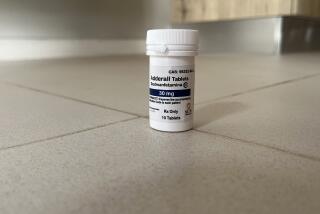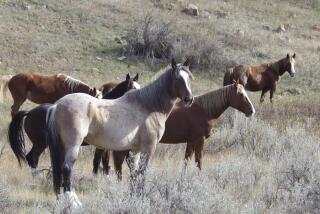Workers Under Towers Are Well-Wired but Clueless
Some people have careers working on the radio. In the City of Industry, hundreds have jobs working under it.
They are employees at an unusual warehouse and distribution center built beneath five commercial broadcast towers that send music and talk across the Los Angeles area.
But don’t ask those working in the offices and stock rooms of the Towers Industrial Park at the corner of 6th Avenue and Don Julian Road what’s on the air. They can’t hear a bit of the programming -- even though some of them are just a few feet away from the transmitters of KTNQ-AM (1020) and KXTA-AM (1150).
Chicken wire that helps form the walls, ceiling and floors of the 522,000-square-foot warehouse center is the reason for that.
The flimsy poultry-pen fencing shields workers from the radio stations’ combined 100,000 watts of radiated power. It also blocks the Spanish-language oldies music played by KTNQ and the sports talk produced by KXTA that almost everyone else with a radio in the Los Angeles area can pick up.
A heavier wire net suspended over a driveway and parking lot between the center’s two buildings protects cars and trucks from the overhead electrical field. The five 500-foot-tall towers rise through the roofs of the buildings. The bottom 25 feet of each shaft is enclosed in a concrete well laced with copper wire that resembles a door-less room inside the warehouse.
Most of the industrial park workers don’t realize that their place of business -- built in 1990 -- represents an unusual attempt to use land around the directional AM “amplitude modulation” broadcast towers.
Some think the towers are used for cellular telephones. Others speculate they are part of a landing system for airplanes. Or leftovers from some Cold War missile-defense program.
“I’ve tried to ask but nobody seems to know,” said Andy Woo, who works at a furniture warehouse at the center. “My theory is, it’s to warn pilots away from chemicals or something in this area that they don’t want aircraft to hit.”
Automotive supply worker Israel Curieo said he figures that the wire netting suspended over the parking lot and his loading dock is there to catch the towers in case they fall over in an earthquake.
Carlos Aispuro, service manager for a shipping company, said he uses the towers as a landmark to direct customers to his office, which is in a corner of the center. “I haven’t got a clue what they’re for,” he said.
Aispuro, who was raised about five miles away in Baldwin Park, said he remembers seeing the towers when he grew up. At that time, they were surrounded by a vacant field.
Owners of the land decided in the late 1980s to develop the empty property beneath the towers. The site is now owned by institutional investors, according to its leasing agent.
“Land is becoming more valuable as cities expand out toward the country where radio stations were built decades ago,” said Ronald Rackley, a Sarasota, Fla., electrical engineer and an expert in electromagnetic radiation.
Rackley was among those who helped design the warehouse project so that radio waves from KTNQ wouldn’t harm construction workers as they built it or employees after it was built.
Although FM radio stations can use a single transmission tower atop a building, directional AM stations such as KTNQ’s require a more elaborate setup. The number and positions of an AM stations’ towers keep signals from interfering with each other by focusing them in a certain direction.
To make things more complicated, the entire broadcast tower, not just the point on top, serves as the “antenna” for an AM radio transmitter. And a 500-foot tower requires 120 copper-wire “radials,” each buried in the ground and extending 500 feet out like beams from the sun, for the transmitter to properly work.
Adding to the difficulty were the 30 thick support cables that hold up the five towers. Many of them had to be altered to make room for the buildings and parking lot.
After studying various radiation shields, Rackley settled on chicken wire. Construction workers were ordered to carefully layer it inside concrete walls and floors and wooden roofs.
“Finding that much chicken wire was one of my biggest challenges,” recalls Bob Prizio, whose Anaheim contracting firm handled the concrete work. He bought up all the locally available chicken wire and then turned to an Arizona farm supply company to find the rest of the 1.25 million square feet he needed.
KTNQ, meantime, remained on the air above everyone’s heads.
“We’d occasionally leave out power cords for our tools over the weekend, and they’d collect the electrical energy. You’d pick up the cord and touch the plug on Monday and you’d get a nasty burn,” Prizio said.
“We could hear Mexican music coming from the base of the antennas when we put up the concrete forms for the wells around the towers. My Mexican workers were dancing,” he said.
Rackley eventually co-wrote a paper explaining the project to a National Assn. of Broadcasters convention. After that, buildings began popping up beneath AM radio towers around the country.
Several years after the industrial park was finished, KXTA leased tower space there so it could boost its signal strength for Dodgers broadcasts. Special filtering was added so the two stations’ competing AM signals wouldn’t interfere with one another.
The unusual transmitter site still attracts attention from broadcasters, said Michael Callaghan, chief engineer of KXTA. “That one is unique. People come and ask us just to see it,” he said.
Those at the industrial park take it all in stride.
“Sometimes you hear talking coming through the fax machine. And in heavy wind you can hear the creaking from the towers and wires,” said a fabric company administrative assistant, Joann Davis.
Tony Tsou, president of a wholesale computer firm, said the radio towers’ signals don’t affect his computers.
“Everybody wonders what the wire-mesh thing is over the parking lot. But they’ve figured out a way to use both the air and the ground here and we don’t mind,” said Sargon Mikhail, who works at a paint supply company. He said he’s not worried about the towers’ electromagnetic energy.
“Of course,” he laughed, “if I wake up one day with an extra hand growing on my arm because of the radiation, that’ll be a different story.”
More to Read
Start your day right
Sign up for Essential California for news, features and recommendations from the L.A. Times and beyond in your inbox six days a week.
You may occasionally receive promotional content from the Los Angeles Times.







